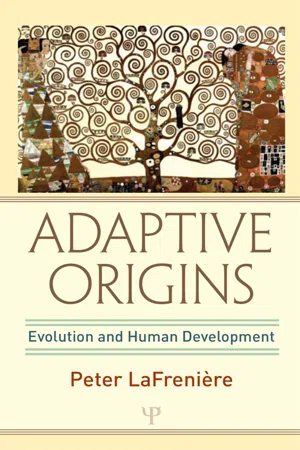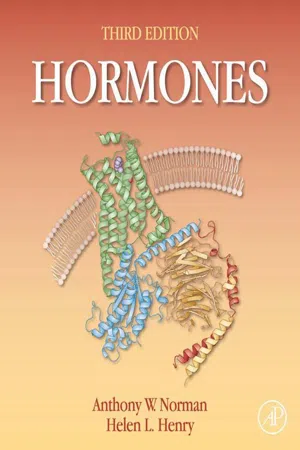Psychology
Hormones
Hormones are chemical messengers produced by the endocrine system that regulate various bodily functions and behaviors. In psychology, hormones play a crucial role in influencing emotions, stress responses, and overall mood. They can impact cognitive processes, such as memory and learning, and are also involved in the regulation of sleep and appetite.
Written by Perlego with AI-assistance
Related key terms
11 Key excerpts on "Hormones"
- eBook - ePub
- Gail Anderson(Author)
- 2019(Publication Date)
- CRC Press(Publisher)
7 The chemistry of the body The effects of Hormones on behavior Introduction This chapter is one of several that considers the areas of biology that do not directly deal with genetics, although Hormones and neurotransmitters are controlled by genes. It first provides a brief overview of the normal function of Hormones and how they influence behavior. There is a very fine control kept on hormone levels through negative feedback mechanisms, and this system in turn is one of the controls of behavior. One of the most hotly contested areas in biological criminology relates to the so-called male and female Hormones, as well as their relationships with other Hormones. Hormone imbalances are treated medically every day, which means that as greater understanding is achieved, better interventions may be developed. The functions of Hormones Hormones (from the Greek word hormon, meaning to excite or to set in motion) are chemical signals. They are released into the blood by endocrine cells (the building blocks of the endocrine system, which include the hypothalamus, pituitary, and thyroid glands) and neurosecretory cells, which are specialized nerve cells that also make Hormones. These cells sometimes release the Hormones directly, but they also often store them in a gland for later release (for example, the digestive glands or the pancreas). Once something gets into the bloodstream, it will reach every cell in the body, because that is what the blood is designed to do—to take oxygen and nutrients to every single cell and take away waste products, such as carbon dioxide and nitrogenous waste. However, although the Hormones will get to every cell, only certain types of cells, the target cells for that particular hormone, will respond. The other cells will ignore it - eBook - ePub
Stress and Your Health
From Vulnerability to Resilience
- Hymie Anisman(Author)
- 2015(Publication Date)
- Wiley-Blackwell(Publisher)
5 Hormones and What They DoHormonal release to deal with stressors
Humans and animals have exquisitely well-integrated adaptive neurobiological systems that allow us to deal with stressors. We even have compensatory processes that kick in when a primary system stops operating effectively. Yet, each of us has weaknesses owing to genetic factors, prenatal or early postnatal experiences, or responses that developed over time when the stress load became excessive. The weak link in one individual might not be the same as that in a second, and thus identical stressors may elicit different outcomes. For one individual this might comprise processes leading to psychological disturbances, and for another it might promote the development of immunological, cardiovascular, muscular, or gastrointestinal illnesses. In some unfortunate individuals stressors might increase vulnerability to several pathological conditions.Hormones comprise biochemical substances that are secreted from glands or cells in the body and in the brain in response to internal signals, such as altered sugar levels in the blood, as well as environmental stimuli, such as stressors. They operate to help the body meet its needs, including the activation of metabolic processes, initiation and cessation of eating, regulation of immune activity, preparing the body for transitional phases of life (puberty, parenting, bonding, menopause), and the functioning of reproductive processes, and they contribute to cell growth and the normal course of cell death. They also affect our ability to contend with stressful events by influencing our readiness to make appropriate behavioral or emotional responses, modifying cognitive processes and promoting physiological changes, including energy regulation, as well as immune and heart functioning. That’s a pretty impressive load for these tiny chemical molecules, but weak links may be present so that hormonal dysfunctions might occur in the context of stressful situations, thereby increasing vulnerability to illnesses of one form or another. - eBook - ePub
Adaptive Origins
Evolution and Human Development
- Peter LaFrenière(Author)
- 2011(Publication Date)
- Psychology Press(Publisher)
CHAPTER 6 Hormones and Behavior* Hormones represent a group of neurochemicals that is quite distinct from the neurotransmitters discussed in the preceding chapter. Hormones are produced by the endocrine system which interacts with the nervous system mainly through connections between the hypothalamus and the pituitary just beneath it. The hypothalamus produces some Hormones, such as oxytocin, and sends them via its axons as neurotransmitters to the pituitary for storage and release into the bloodstream where they can act on their target tissues. The hypothalamus also produces releasing Hormones that reach the pituitary through special arteries and that stimulate the pituitary to produce various other Hormones of its own (see Figure 6.1). Most of these pituitary Hormones act on other endocrine glands to stimulate them to produce Hormones that act on final target tissues. An example is the HPA (hypothalamus-pituitary-adrenal cortex) system. The hypothalamus produces the releasing hormone CRF, which stimulates the pituitary to produce ACTH, which in turn stimulates production of the adrenal corticosteroid Hormones, such as cortisol, which cause adjustments to stressful situations. Because they travel via the bloodstream, Hormones usually require more time to have an impact on the body than neurotransmitters whose impact on the generation of an action potential in the neuron’s axon occurs in nanoseconds. FIGURE 6.1 Many Hormones are produced by the hypothalamus and the pituitary. □ Evolution of Hormones In comparing Hormones and neurotransmitters, it is useful to understand their evolution. The current evolutionary model (Snyder, 1985) is presented in Figure 6.2. The first and most basic form of chemical communication (model a) evolved to provide a primitive form of intercellular communication so that the organism could behave as a unit rather than a collection of uncoordinated cells - eBook - ePub
The SAGE Handbook of Personality and Individual Differences
Volume II: Origins of Personality and Individual Differences
- Virgil Zeigler-Hill, Todd K. Shackelford, Virgil Zeigler-Hill, Todd K. Shackelford(Authors)
- 2018(Publication Date)
- SAGE Publications Ltd(Publisher)
Hormones, it turns out, are important contributors to our personality. Many Hormones exert an influence on our motivations, moods, and relationships with other people, to list a few of their contributions, in addition to their major known biological function, such as carbohydrate metabolism and tissue development. Of course, normally, Hormones are allowed to respond to our internal and external environments, something that Davidson's experience with hormone injection inevitably cannot portray. Thus, our understanding of the role of Hormones on personality is far more nuanced than anecdotal influences of steroid abusers could suggest. In this chapter, we will discuss what Hormones are and how they are assessed; as well as point out ways this approach to assessing personality differs from more traditional personality assessment techniques. Although using Hormones to predict behavior – especially when these Hormones can be experimentally manipulated – provides many exciting opportunities, they also pose unique challenges. We will then give a synopsis of the current state of our understanding of the influences of commonly studied Hormones on personality. For the purposes of this chapter, however, we will limit our discussion of the literature to studies that focus on human participants. Although we are able to learn many things about human personality through comparative research (Gosling, 2001), inclusion of this literature is beyond the scope of what we are able to discuss. Additionally, we will limit our discussion of Hormones to those found outside the central nervous system and to their peripheral effects. Most research conducted with humans does not test for Hormones in the central nervous system as the method of assessment involves the use of a spinal tap to withdraw cerebrospinal fluid, a highly invasive procedure. Researchers wishing to learn more about the influence of a specific hormone on personality or effects within the central nervous system should also look to studies with non-human animals as much of our mechanistic understanding, in addition to the primary basis for early work with humans, builds off this literature.Hormones and how they are measured
Broadly speaking, Hormones are chemicals produced in one part of the body that have to travel to a target receptor site in a location separate from where they are produced. Although research into the role of Hormones on personality is relatively recent, it is not a new proposition that a biological agent moving throughout the body affects our personality. Greek physicians such as Hippocrates and Galen proposed that our health and personality are dependent on the balance of four bodily fluids (i.e., yellow bile, black bile, blood, and phlegm), and Freud theorized that personality develops from libidinal energy that navigates through the body to target locations. Although the specifics of these approaches have been largely abandoned, the focus on finding a biological basis to personality has not. In recent years, researchers have added to our understanding of personality by integrating findings from affective neuroscience and neurobiology (e.g., Canli, 2006). And, just as functional magnetic resonance imaging (fMRI) technologies have allowed researchers the opportunity to peer inside the working brain, the emergence of non-invasive hormone sampling techniques has allowed researchers to incorporate Hormones in their studies with human participants. - eBook - ePub
Biophysical Measurement in Experimental Social Science Research
Theory and Practice
- Gigi Foster(Author)
- 2019(Publication Date)
- Academic Press(Publisher)
The sociologist Emil Durkheim knew, reasonably accurately, how many people would commit suicide each year. His problem was that he did not know who these people were. So, it is with much social science: we know what people will do on average but struggle to predict what a given individual will do. The gap between aggregate prediction and individual behavior has proved both vexatious and fruitful for social scientists. Whilst it has frustrated attempts to predict individuals’ actions, it has also given birth to new fields. In economics, for example, this disparity between aggregate and individual behaviors helped give birth to the field of behavioral economics.Behavioral economics, like much of social science, stops at the skin. The mechanisms of how and why people act the way they do is inferred from behavior and dissected through cunningly-wrought experiments. What is often missing is an understanding of what actually happens inside a person’s body when they do the things that the social scientist is interested in. More recently this has begun to change. Disciplines such as neuroeconomics have attempted to tease apart the processes by which preferences are formed and maintained (see, for example, Chapters 2 and 3 of this volume). Psychologists have used functional magnetic resonance imaging (fMRI) and electroencephalograms (EEG) to evaluate the brain processes underpinning behavior. Despite this, many social scientists still adhere to the precept that what really matters are the inputs into the body and the subsequent behavioral outputs.Like much of this book, this chapter aims to get under the skin of human behavior by looking at some of the physiological processes underpinning it. This chapter specifically examines the role of steroid Hormones. Hormones are chemical messengers that travel around the body, changing the way cells behave. Steroid Hormones are a subset of this group that affect every nucleated cell in the body—including those in the central and peripheral nervous systems. Consequently, steroid Hormones have profound effects on many of the processes that social scientists are interested in. By studying them we can peek inside the black box of human behavior and understand more fully the mechanisms that underpin it.Human physiological mechanisms are similar across individuals. Evolution has produced systems that enable the organism to regulate and maintain its internal milieu, and these systems are highly conserved. This has two important implications for social scientists. First, factors such as culture or race are largely irrelevant physiologically—so physiological principles are applicable across groups. Second, it means that the consequences of physiological processes may be felt not only at an individual level but at a societal one too (see Coates, Gurnell, & Sarnyai, 2010 ; Coates, 2012 - eBook - ePub
The Sage Handbook of Cognitive and Systems Neuroscience
Neuroscientific Principles, Systems and Methods
- Gregory J. Boyle, Georg Northoff, Aron K. Barbey, Felipe Fregni, Marjan Jahanshahi, Alvaro Pascual-Leone, Barbara J. Sahakian, Gregory J. Boyle, Georg Northoff, Aron K. Barbey, Felipe Fregni, Marjan Jahanshahi, Alvaro Pascual-Leone, Barbara J. Sahakian(Authors)
- 2023(Publication Date)
- SAGE Publications Ltd(Publisher)
12 Hormonal Influences on Cognition Linda Becker and Nicolas Rohleder Introduction Hormones are messenger molecules that are released by endocrine glands within the body and also by specialized neurons within the brain. Free circulating Hormones in the bloodstream or in the interstitial fluid interact with the brain through positive and negative feedback loops, which can be related with changes in cognitive functioning. In general, there are two different classes of Hormones, mainly distinguished by their biochemical characteristics, which have direct effects on the way they gain access to, and signal to target cells. The two main classes are steroid Hormones and peptide Hormones. One class of Hormones are steroid Hormones. They are synthesized from the precursor molecule cholesterol. Important steroid Hormones are glucocorticoids (e.g., the stress hormone cortisol), mineralocorticoids (e.g., aldosterone), and sex Hormones (e.g., testosterone, estradiol, and progesterone). Steroid Hormones are highly stable and typically bound to transport proteins in the blood. In their free form (i.e., when they are not bound to proteins), steroid Hormones can pass through cell membranes. Importantly, they can pass the blood-brain barrier (BBB), and can therefore, affect neural and brain processing directly. A further important class of Hormones are peptide Hormones, short protein molecules, which are composed of a small number of amino acids. Relevant peptide Hormones are adrenocorticotropic hormone (ACTH), epinephrine (EPI), norepinephrine (NE), and oxytocin. As opposed to steroid Hormones, peptide Hormones cannot easily cross cell membranes. Therefore, they cannot pass the BBB either and can (in most cases) not alter cognitive functions directly. However, mechanisms to circumvent this restriction have been described (e.g., through activating nerves such as the vagus nerve in the periphery that can then alter brain function through this neural pathway; cf - eBook - ePub
- D. B. Ferguson(Author)
- 2014(Publication Date)
- Butterworth-Heinemann(Publisher)
12Endocrine systems
Publisher Summary
This chapter discusses the characteristics and functioning of endocrine systems. Hormones, or endocrine secretions, have traditionally been defined as chemical substances secreted directly into the bloodstream from a specialized tissue and producing effects on distant organs. They are a pathway of communication alternative to the nervous system, differing from it in being slower, but at the same time more suitable for widespread integrated activity in a number of effector organs or cells. Endocrine systems are suitable for mediating changes in activity of many organs together, particularly when the responses are required in minutes, or hours, or days, rather than in fractions of a second. In general, Hormones increase or decrease the activity of target organs or cells; they rarely initiate activities. Although many Hormones are secreted at a low basal rate, few maintain a constant level of production as their secretion is adjusted in response to nervous stimuli or to changing conditions around the secreting glands. Hormones are messenger substances, passing information from one cell to another, usually through the circulatory system, and often over great distances. A number of Hormones are protein or glycoprotein molecules that are able to travel easily in the bloodstream without the need for carrier molecules..Hormones, or endocrine secretions, have traditionally been defined as chemical substances secreted directly into the bloodstream from a specialised tissue and producing effects on distant organs. They are a pathway of communication alternative to the nervous system, differing from it in being slower, but at the same time more suitable for widespread integrated activity in a number of effector organs or cells. Endocrine systems are suitable for mediating changes in activity of many organs together, particularly when the responses are required in minutes, or hours, or days, rather than in fractions of a second. The rapid, but transient, response of the nervous pathways would be inefficient in controlling processes such as growth and reproduction, or in modifying metabolic activity, or maintaining ordered bodily rhythms. - eBook - ePub
- I. W. Jennings(Author)
- 2014(Publication Date)
- Butterworth-Heinemann(Publisher)
Chapter 3Hormones
Publisher Summary
This chapter provides an overview of Hormones. A major part of the control of bodily function is exercised by the nervous system, which directs organs or tissues to carry out certain processes voluntarily or involuntarily such as contraction of muscle, outpouring of glandular secretion, or even storage of information. Supplementary assistance in the execution of these orders is given by the Hormones. These are highly specialized chemical messengers, essential to normal life, which modify the activity of their target organs or cells in such a way as to alter their pattern of behavior. They are able to exert their influence even when present in exceedingly small concentration. In many respects, they resemble the vitamins. Hormones resemble vitamins too in that deficiency, however caused, results in recognizable disease and excessive amounts cause symptoms of toxicity. Hormones are secreted by the endocrine glands or tissues. The chapter analyzes the methods of investigation of hormonal action. There are many methods for the assay of Hormones in current use in clinical and experimental trials. Immune assay and radioimmunoassay are delicate methods for studying variations in circulating levels of protein Hormones, while gas and paper chromatography can be used for assay of steroid Hormones. The chapter also describes the mode of action of Hormones.The higher animal organism is a wonderfully complex arrangement of numerous interdependent organs, each composed of many different tissues, none of which is able to function in isolation. Obviously, smooth working of such a complicated mechanism is not easily achieved. Control must be exercised over each individual organ and tissue so that the animal may adjust to the everchanging nature of its external environment and to the constant and inexorable demands of its tissues for nourishment. The motivation for these demands lies in the inborn impulse for survival and less urgently in the biological desire to perpetuate the species. A major part of the control of bodily function is exercised by the nervous system which directs organs or tissues to carry out certain processes voluntarily or involuntarily, such as contraction of muscle, outpouring of glandular secretion or even storage of information. Supplementary assistance in the execution of these orders is given by the Hormones. These are highly specialized chemical messengers, essential to normal life, which modify the activity of their target organs or cells in such a way as to alter their pattern of behaviour. They are able to exert their influence even when present in exceedingly small concentration. In many respects they resemble the vitamins, and in fact the steroid Hormones are more closely related chemically and functionally to the fat-soluble vitamins than they are to the protein Hormones. It is quite rational to think of Hormones as endogenous vitamins, or to think of vitamins as exogenous Hormones. The functions of the two overlap, and as far as we know their modes of action may be quite similar. In the case of vitamin C, which is synthesized from simple precursors by domestic animals, but not by man, it would be quite appropriate to refer to it as a vitamin for man, and a hormone for domestic animals. Hormones resemble vitamins too in that deficiency, however caused, results in recognisable disease, and excessive amounts cause symptoms of toxicity. The margin between deficiency and excess is a narrow one. - eBook - ePub
- Meera Yadav, H.S Yadav(Authors)
- 2021(Publication Date)
- Bentham Science Publishers(Publisher)
HormonesNagendra Nath Yadav,1 , *Archana Pareek11 Department of Chemistry, Nerist, Nirjuli, Itanagar-791109 (AP), IndiaAbstract
This chapter includes an introduction, classification, and type of Hormones, as well as their biological functions. This chapter also gives a brief discussion about the structure, properties, and regulatory action of Hormones. Various plant Hormones and their functions have been discussed in this chapter.Keywords: Cortisol, Osteoporosis, Oxytocin, Plant Hormones, Progesterone, Sex Hormones, Testosterone, Vasopressin.* Corresponding author Nagendra Nath Yadav: Department of Chemistry, NERIST, Nirjuli, Itanagar-791109 (AP), India. E-mail:[email protected]Introduction
The term ‘hormone’ is derived from the Greek word ‘hormaein’, which means “to set in motion”. Hormones are specific molecules that act as chemical messengers. These are secreted directly into the blood by the endocrine glands. These are carried by the circulatory system to organs and tissues of the body to exert their functions [1 ]. The major body functions include monitoring of basic needs, hunger, to a complex mechanism like reproduction [2 ]. The Hormones secreted into the blood come in contact with a number of cells, but only certain target cells are influenced by these. For each specific hormone, there are specific receptors in the target cells, which may be present on the surface of the cell membrane or inside the cell. As the hormone binds to the receptor, some changes occur, influencing the cellular function. Since the Hormones influence the target cells over a distance hence this type of signaling is known as endocrine signaling [3 ]. Hormones also influence the neighboring cells when secreted into the interstitial fluid surrounding cells, which then diffuse to nearby target cells. This type of signaling is known as paracrine signaling. Sometimes the Hormones cause changes to the same cell that releases them and do not enter the other cells, known as autocrine signaling [3 - eBook - ePub
- Anthony W. Norman, Helen L. Henry(Authors)
- 2014(Publication Date)
- Academic Press(Publisher)
Chapter 1Hormones
An Introduction
The objective of this book is to provide a status report on the field of human Hormones, viewed in the light of the current understanding of cellular and subcellular architecture, as well as the molecular details of their mode of action. In this first chapter, some of the first principles of hormone action are presented as a foundation for the more specific considerations of individual hormonal systems in the chapters that follow.Keywords
Endocrinology; hormonal communication; hormone; hormone biosynthesis; hormone receptorsI Overview of Hormones
A Introduction
The term “hormone” is derived from the Greek hormon , the present participle of impel , or set in motion , an apt characterization of these potent molecules. “Endocrine” is also derived from the Greek: endo - for internal or within and krinein meaning separate . This term conveys the distance of the site of secretion from the site of action that characterized the systems, such as the pancreas, the thyroid, and the reproductive glands that were studied in the early days of endocrinology.The cellular constituent that is the immediate recipient of the hormone is the receptor, an entity whose importance is now so dominant in the study of Hormones that it is hard to imagine that the existence and nature of these molecules were not appreciated until the early 1970s. The biochemical organization of receptors is diverse but each receptor is structurally organized so that it can specifically recognize and interact with its hormone. Because of the low circulating concentrations of the Hormones, the receptor must have a very efficient “capture” mechanism for its hormone. As a consequence of the receptor–hormone interaction (however transient it may be), signal transduction occurs and a specific biological response(s) is generated within and, in some instances, around the target cell—i.e., the cell responds to the presence of the hormone. - eBook - ePub
- Linda Costanzo(Author)
- 2021(Publication Date)
- Elsevier(Publisher)
Chapter 9: Endocrine physiology
- Hormone Synthesis, 399
- Regulation of Hormone Secretion, 403
- Regulation of Hormone Receptors, 405
- Mechanisms of Hormone Action and Second Messengers, 406
- Hypothalamic-Pituitary Relationships, 411
- Anterior Lobe Hormones, 413
- Posterior Lobe Hormones, 418
- Thyroid Hormones, 423
- Adrenal Medulla and Cortex, 431
- Endocrine Pancreas, 444
- Regulation of Calcium and Phosphate Metabolism, 451
- Summary, 462
- Challenge Yourself, 463
The endocrine system, in concert with the nervous system, is responsible for homeostasis. Growth, development, reproduction, blood pressure, concentrations of ions and other substances in blood, and even behavior are all regulated by the endocrine system. Endocrine physiology involves the secretion of Hormones and their subsequent actions on target tissues.A hormone is a chemical substance that is classified as a peptide, a steroid, or an amine. Hormones are secreted into the circulation in small amounts and delivered to target tissues where they produce physiologic responses. Hormones are synthesized and secreted by endocrine cells usually found in endocrine glands. Table 9.1 provides a list of Hormones and their abbreviations, which are used throughout Chapters 9 and 10 .TABLE 9.1 Commonly Used Abbreviations in Endocrine PhysiologyAbbreviation Hormone Abbreviation Hormone ACTH Adrenocorticotropic hormone LH Luteinizing hormone ADH Antidiuretic hormone MIT Monoiodotyrosine CRH Corticotropin-releasing hormone MSH Melanocyte-stimulating hormone DHEA Dehydroepiandrosterone PIF Prolactin-inhibiting factor (dopamine) DIT Diiodotyrosine POMC Pro-opiomelanocortin DOC 11-Deoxycorticosterone PTH Parathyroid hormone FSH Follicle-stimulating hormone PTU Propylthiouracil GHRH Growth hormone–releasing hormone SRIF Somatotropin release–inhibiting factor GnRH Gonadotropin-releasing hormone T3 Triiodothyronine HCG Human chorionic gonadotropin
Index pages curate the most relevant extracts from our library of academic textbooks. They’ve been created using an in-house natural language model (NLM), each adding context and meaning to key research topics.










